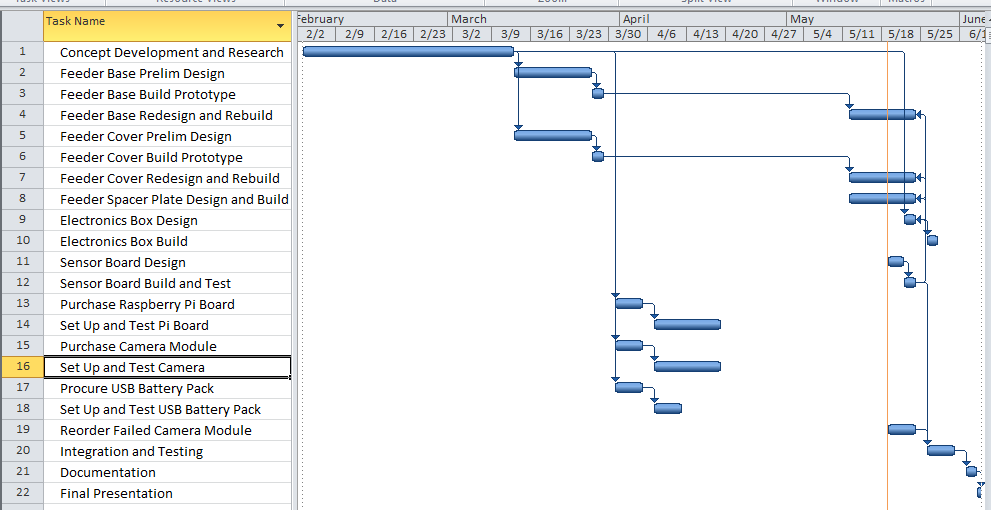Project Title: Intelligent Hummingbird Feeder
This interim update was documented approximately
3 weeks prior to the project end date. The final outcome and all
the project details are documented in the Final Project page.
Project Plan

Completed Task Summary
- The feeder design has been completed and
prototyped, with some remaining modifications to be done on
the cover.
- The Pi board has been set up and verified.
- The Pi camera module been set up and
functionality has been learned. Unfortunately, the camera has
subsequently failed and a replacement has been ordered.
- The Python software has been developed and
tested in a demo setup.
Remaining Task Summary
- The biggest challenge remaining is the sensor
board design and testing. This design has just started due to
other time commitments.
- The Pi camera module has failed and a
replacement has been ordered.
- The top cover requires some design
modifications and will then need to be reprinted.
- Python code will need to be modified in the
final configuration.
- Final camera location needs to be determined.
What questions need to be resolved?
- Sensor board design
- Will Capacitive Sensing work in this
application?
- Camera selection - will Pi camera work?
- Camera location for best photos.
- Will birds use the feeder in the field?
Risks
- The timing for replacement camera arrival is a
risk.
- The sensor board design is a risk (if it needs
more than one iteration).
What has and has not worked (updated at end of project)?
- The feeder design and box and prototyping went
well and the final design is very good.
- The Ping Ultrasonic sensor works very well in
this application.
- The Raspberry Pi board works well and the
documentation available is very good.
- Capactive Sensing did not work in a repeatable
and robust way. It also consumed a very significant amount of
time without a productive outcome.
- The Raspberry Pi board is awkward in terms of
setup and multiple cables are required (in addition to monitor
and keyboard).
- The camera module is challenging and difficult
to position for testing purposes. In addition, the ability to
control the camera focus is not clear.
- The camera module is apparently very
susceptible to static (which may be the cause of my two
failures).
- Eventually, I abandoned the Pi camera module
and switched to a regular Webcam.
- The Electronics Box design was adequate but
could have been better in terms of component placement and
retention.
Learnings
I have learned a tremendous amount through this
process.
- How to design and build a circuit board.
- How to use Solidworks (but still have a lot to
learn).
- How to use Inkscape for 2D design.
- How to use the Laser Cutter, Shopbot, Modela,
Stratasys 3D printer and many other pieces of equipment.
- How to do basic programming in C and Python.
- How to use the Raspberry Pi and Camera.
- How to deal with Windows frustration (many
hours wasted trying to download applications).
- The basics of Arduino.
- Soldering irons hurt when they touch your
skin.
- Excellent sources of information and how to
use them.
Time Management
During the Fab Academy Course, I have managed my
time in order to complete and document the weekly projects. Where
possible, I have tailored the weekly project to contribute to the
final project. Good examples are 3D printing and Applications.
I do have a disproportionate amount of remaining work in the final
2 weeks but this was understood from the start (due to work
schedule).